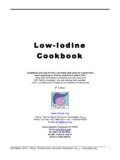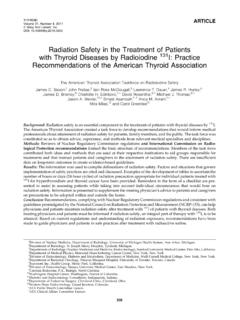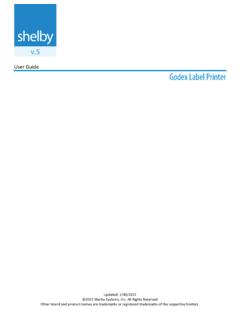Transcription of Low-Iodine Diet Quick Guide - ThyCa
1 Low-Iodine Diet Quick Guide November 2020 ThyCa : Thyroid Cancer Survivors Association, Page i Thank you for using this Low-Iodine Diet (LID) Quick Guide and cookbook introduction. This Guide has two purposes. One is to serve as a stand-alone document for anyone who wants a Quick summary of the LID without having to download the entire cookbook. It is also designed to serve as the cookbook s introduction. It contains the following sections: Welcome About ThyCa Invitation About Photocopies and Use Disclaimer Sources The Low-Iodine Diet General Overview Helpful Tips Foods to Avoid Foods to Enjoy, But in Limited Quantity Foods to Enjoy Variations of the LID and Editorial Remarks from ThyCa Processed & manufactured foods Eating out/Restaurant Food and Take-Out Foods we are often asked about, etc. Pantry items Reading Labels Going Shopping A Week s Worth of Easy Menus Breakfast Inspiration Lunch Inspiration Dinner Inspiration Snacks Miscellaneous topics Vitamins/Minerals and Supplements Other Ways Iodine Enters Our Bodies CT contrast Topical antiseptics Skin care & toiletry items Food dye Drugs & OTC medications handy One-Page LID Summary Key Points Foods to Avoid Foods to Enjoy Easy Snacks for Home, Work, or Travel Easy Quick Meals Disclaimer Welcome The information we provide comes from several members of ThyCa s Medical Advisory Council, plus a team of ThyCa volunteers.
2 The LID has been used successfully for decades. We are continually updating and fine-tuning it to bring you the most comprehensive LID available. About ThyCa : Thyroid Cancer Survivors Association, Inc. SM ThyCa , founded in 1995, is an international nonprofit 501(c)(3) organization of thyroid cancer survivors, family members, and health care professionals, serving people worldwide. We are dedicated to education, communication, support, awareness for early detection, and thyroid cancer research fundraising and research grants in support of our goal of cures for all thyroid cancer. Visit our website for detailed thyroid cancer information, videos with experts, free publications and materials in multiple languages, links to our free online and local support groups, plus more free services. Learn about how to donate, volunteer, or become a member.
3 Find the latest details about educational events, including the annual International Thyroid Cancer Survivors Conference. Invitation: If you would like to comment on any recipes, or submit new ones, please write to Your recipe will be reviewed for LID compatibility. We may incorporate your recipe(s) into a future edition, feature it in our monthly bulletin, or add it to our website s Recipedia. Low-Iodine Diet Quick Guide November 2020 ThyCa : Thyroid Cancer Survivors Association, Page ii About Photocopies and Use: You are welcome to download and print out this Quick Guide and our cookbook from You are also welcome to photocopy complete pages and give them to others. Please include the ThyCa information at the bottom of the page so that others in need of support can easily find us. Please note the material in this book is not for commercial use.
4 Disclaimer: The information contained here is intended for educational purposes only. It is not intended, nor should it be interpreted, as medical advice or directions of any kind. Any person viewing this information is strongly advised to consult their own medical doctor(s) for all matters involving their health and medical care. Sources: (1) Diet guidelines provided by several members of ThyCa s Medical Advisory Council; (2) Presentations and handouts from our conference and workshop speakers from 2000 through Spring 2010. Speakers have included Stephanie L. Lee, MD, PhD, Endocrinologist, Boston Medical Center, Massachusetts; Christina Reiter, MS RD, Resident Dietitian, University of Colorado, Boulder, Colorado; and Nancy Sebring, MEd, RD, Research Dietitian, National Institutes of Health, Bethesda, Maryland; (3) Medical journal articles, including Pearce EN, Pino S, He X, Bazrafshan HR, Lee SL, and Braverman LE, Journal of Clinical Endocrinology and Metabolism 89(7):3421-3424.
5 2004; Park JT and Hennessey JV, Thyroid (1):57-63. 2004; and more recent articles; and (4) USDA, FDA and ODS-NIH Database for the Iodine Content of Common Foods Release The Low-Iodine Diet (LID) General Overview: Thyroid cancer patients with papillary or follicular thyroid cancer often receive radioactive iodine (RAI). RAI (either I-123 or I-131) is used in small tracer doses for imaging/testing/scanning. The results can inform next steps, sometimes resulting in RAI ablation. A larger dose of RAI (I-131) is sometimes used to destroy (or ablate) any remaining thyroid cells and thyroid cancer cells. Some patients receive this treatment more than once. Thyroid tissue, and most thyroid cancer tissue, naturally absorbs or takes up iodine, to make thyroid hormones. Therefore, for the treatment and/or scans to be most effective, our bodies need to have elevated TSH (thyroid stimulating hormone) along with being iodine-hungry.
6 This is why patients are often asked to go on a short-term Low-Iodine Diet to temporarily starve our bodies of iodine. The American Thyroid Association, as well as most major medical institutions, recommend using the LID to facilitate becoming more iodine-hungry. This allows our bodies to take up as much radioactive iodine as possible. We acknowledge that the word diet has different meanings to different people. This is not a diet in the sense of a mechanism for weight loss or eating healthy. Rather, it is a medically necessary short-term regimen needed to help our bodies become iodine-hungry. Preparation for RAI can take place in one of two ways, both resulting in the necessary elevated TSH. Both of these processes incorporate use of the LID: 1. Remaining on thyroid replacement hormone (usually levothyroxine please refer to the Know your Pills section at for more information) while receiving Thyrogen (recombinant TSH) injections.
7 Some people experience symptoms of hypothyroidism using Thyrogen. 2. Withdrawing from thyroid replacement hormone for a period of weeks. Sometimes patients spend a portion of their withdrawal time using a different drug called liothyronine. Note that this method can cause symptoms of severe hypothyroidism, including weight gain, lethargy, feeling cold, etc. Low-Iodine Diet Quick Guide November 2020 ThyCa : Thyroid Cancer Survivors Association, Page iii This diet is generally for a short time period, usually lasting 2-3 weeks. It usually begins 2 weeks before swallowing the radioactive iodine (either for testing or treatment) and continues through the testing and treatment period, often for 1 to 3 days after the RAI scan or treatment. However, recommendations for the time period can vary, depending partly on the individual patient s circumstances.
8 Check with your care provider to be certain. The diet presented here is a combination of guidelines from several ThyCa medical advisors (some who use urine iodine testing to check patients iodine levels), from researchers findings presented in medical journals and at ThyCa events, and from input from members of our Medical Advisory Council. Your physician may have different guidelines. Please check with your doctor before you start the diet. Helpful Tips: What may be surprising to you is that salt is permitted on this diet, so long as the salt you use has no added or naturally occurring iodine. Therefore, do NOT use sea salt, which has naturally occurring iodine. Use non-sea salt labeled with a statement such as: This salt does not supply iodine, a necessary nutrient. We have found that Kosher salt is also safe to use. This is not a low-sodium diet.
9 Most foods contain naturally occurring sodium, even if they are salt-free. Low-Iodine sometimes gets confused with low-salt since most table salt is iodized. ( Iodized means extra iodine has been added to table salt to help fight goiter, or enlarged thyroids, since many people do not get sufficient iodine-rich foods in their diet.) For your awareness, table salt is chemically sodium chloride and this differs from the naturally occurring sodium found in food. Sodium in any form is OK, as long as it is not provided as iodized or sea salt. Non-iodized salt is OK for the diet, as long as it is not sea salt. Anything from the sea is iodine-rich and must be avoided. This is a Low-Iodine diet, not a no-iodine diet. The LID aims to reduce iodine consumption to below 50 micrograms (mcg) of iodine per day (which is the American Thyroid Association guideline for a LID; some other published LIDs recommend below 80-100 mcg per day).
10 The normal Recommended Daily Allowance of iodine is 150 mcg per day for adults. One teaspoon of iodized salt can contain over 400 mcg of iodine. Many people consume well over 350 mcg per day just from their normal way of eating. As the previous point reflects, the primary goal of the LID is limiting your overall iodine consumption. Much like a financial budget, this means paying attention to what individual foods cost in iodine content while keeping the big picture in mind. For example, if you do not eat meat, which is moderately high in iodine (see below), you will have more room in your iodine budget to consume iodine from fruit, vegetable, or grain sources. To assist you in your iodine budgeting, while on the diet, you may enjoy Low-Iodine foods (up to 5 mcg per serving). There are a lot of foods that you can eat (see the lists below).










